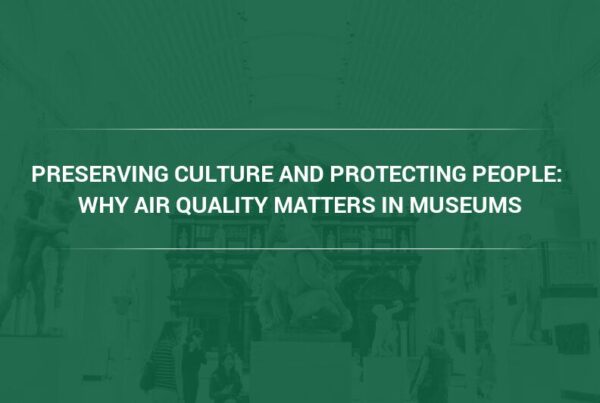Air pollution has long been recognized as a leading environmental health risk, causing respiratory and cardiovascular diseases. But recent research sheds light on another critical, lesser-known impact—its effect on brain health, specifically cognitive function and emotional intelligence. This blog explores the science behind these findings, the implications for mental health, and practical tips for managing air quality in personal and professional environments.
The Basics of Air Quality
Air quality refers to the degree of pollution present in the air, influenced by factors such as emissions, weather conditions, and natural disasters.
Air pollution can broadly be categorized into two types: molecular (or gaseous) and particulate. Molecular pollutants include gases such as carbon monoxide (CO), sulfur dioxide (SO₂), nitrogen oxides (NOₓ), and volatile organic compounds (VOCs). These gases are often emitted from industrial processes, vehicle exhaust, and the burning of fossil fuels. They can have significant effects on respiratory health and contribute to issues like smog and acid rain.
Particulate pollutants, also commonly referred to as particulate matter or particle pollution, consist of tiny solid particles or liquid droplets suspended in the air, known as particulate matter (PM). They are typically classified based on their size: PM10 (particles with a diameter of 10 micrometers or less), PM2.5 (particles 2.5 micrometers or less) and PM1 (particles 1 micrometer or less). Particulate pollutants can originate from sources like construction activities, wildfires, and industrial emissions. These particles are particularly concerning as they can penetrate deep into the lungs and even enter the bloodstream, posing serious health risks.
Understanding these two types of pollution is essential for developing effective strategies to improve air quality and protect human health.
Study Shows Air Pollution Impacts on Cognitive Processes, Including Ability to Recognize Emotions
A 2025 study published in the peer-reviewed journal Nature Communications (2025) exposes the correlation between air pollution and diminished cognitive capabilities.
Cognitive function refers to various mental processes essential for daily activities. Supermarket shopping is a great example of how these functions work independently and together. Executive function, particularly selective attention, helps with decision-making and staying focused on your shopping list while ignoring distractions and avoiding impulse purchases. Working memory acts as a temporary space for holding and processing information, like comparing prices or brands to make smart choices. Socio-emotional cognition allows us to recognize and understand emotions, ensuring smooth social interactions and appropriate behavior while shopping. These cognitive skills, while distinct, operate in harmony to complete everyday tasks. Examining each function individually helps identify which are most affected by air pollution, paving the way for targeted interventions and strategies to build resilience.
The study involved exposing participants to high levels of particulate matter and tracking their cognitive and emotional responses four hours later. Conditions were blinded (meaning that study participants did not know which air quality conditions they were exposed to) so that knowledge or perception of air pollution exposure didn’t confound results. Findings showed impairments in key brain functions:
- Selective attention – the ability to focus on specific tasks while ignoring distractions.
- Emotion recognition – the capacity to interpret and respond to emotional cues in the environment, such as the ability to
Selective Attention
Selective attention is the ability to focus on specific stimuli for further processing while ignoring irrelevant or distracting inputs. Distractions can come from external sources, like background noise or visual clutter, or internal ones, such as wandering thoughts or habitual responses that interfere with the task at hand. Selective attention is essential for complex analytical tasks, such as learning a new language or solving math problems, but also for basic daily tasks, such as choosing what to eat or engaging in conversation.
In the study, selective attention was measured by assessing participants’ reaction time (RT) in seconds. The change in reaction times (before exposure to either the clean air condition or the pollution condition and after exposure) was analyzed, and researchers found a statistically significant increase in reaction time (indicating a decrease in selective attention) under the pollution condition, and a statistically significant decrease in reaction time (indicating an increase in selective attention) after exposure to clean air. On average, post-exposure reaction times in the pollution condition group were 10 milliseconds slower than in the clean air group.
Emotion Recognition
In the study, researchers focused on emotion discrimination, which is the ability to identify and distinguish emotions conveyed through facial expressions, sounds, body language, and other signals. Emotion discrimination is a critical skill for effective social interaction and communication. Being able to accurately identify and interpret emotions allows individuals to respond appropriately to others’ needs, fostering empathy and strengthening relationships. This skill is particularly important in collaborative environments, where understanding emotional cues can help to de-escalate conflicts, build trust, and enhance teamwork; therefore, it is crucial in both personal and professional relationships.
The study found that acute exposure to PM pollution significantly impaired participants’ ability to recognize emotional expressions compared to clean air exposure, as indicated by a larger performance decline post-exposure. Though a significant main effect of session time was found (meaning that participants’ emotion recognition was generally better the first time it was tested), the decline in performance under the clean air condition was not found to be statistically significant.
Implications of the Study’s Results
Other functions, such as working memory, showed resilience to short-term pollution exposure. This suggests varying vulnerabilities within our brain functions—an area ripe for further exploration.
The authors propose two potential mechanisms for these effects:
- Direct pathway — Particulate matter may directly reach the brain through the olfactory system or cross the blood-brain barrier.
- Indirect pathway — Systemic inflammation triggered by lung exposure to pollutants may harm brain tissue over time.
These findings underscore the pressing need to address air pollution and its multifaceted impact, particularly in urban environments with high PM2.5 levels.
Read More: The Link Between IAQ and Productivity
Managing Air Quality for Health and Well-Being
Fortunately, not all is lost. Understanding and mitigating the influence of air quality on brain health can empower individuals and institutions to protect themselves. Here are actionable steps to improve air quality and safeguard your cognitive and emotional well-being:
- Monitor Air Quality Levels
Sources such as AirNow.gov provide real-time air quality updates based on aggregated data from thousands of air quality monitors across the United States. Individuals can use these services to plan activity for times when pollution levels are lower.
- Ask Facility Managers Questions
Concentrations of air pollutants can be up to fifty times higher indoors than in the surrounding outdoor area. Ask your employer or facility manager at your school if they’ve appointed a CAO, Chief Airgonomics Officer. This is the person in an organization with the responsibility to ensure all reasonable steps are being taken to protect the occupant’s health from poor indoor air quality. During extended breaks, for example, it’s not unreasonable to ask the facility manager to explain what steps are taken to maintain acceptable indoor air quality.
3. Minimize Exposure During High Pollution Events
Avoid outdoor exercises or strenuous activities near high-traffic areas during times of increased pollution, like wildfires or smoggy days.
4. Make Ventilation a Priority
To improve indoor air quality, facilities managers can collaborate with Camfil’s air quality specialists to monitor indoor air quality and determine specific focus areas for improving it.
Here are measures that can be integrated into building strategies:
- When planning new construction, include in the design advanced HVAC systems with the capability to provide high indoor air quality. For existing systems, educate yourself on its capabilities and select air filters that deliver the optimal filtration solution for your facility.
- Work with a quality air filtration supplier who can assist you in developing the appropriate maintenance schedule.
- Educate employees about air pollution’s effects and mitigation strategies and encourage open dialog.
About Camfil Clean Air Solutions
For more than half a century, Camfil has been helping people breathe cleaner air. As a leading manufacturer of premium clean air solutions, we provide commercial and industrial systems for air filtration and air pollution control that improve worker and equipment productivity, minimize energy use, and benefit human health and the environment. We firmly believe that the best solutions for our customers are the best solutions for our planet, too. That’s why every step of the way – from design to delivery and across the product life cycle – we consider the impact of what we do on people and on the world around us. Through a fresh approach to problem-solving, innovative design, precise process control, and a strong customer focus we aim to conserve more, use less and find better ways – so we can all breathe easier.
The Camfil Group is headquartered in Stockholm, Sweden, and has 30 manufacturing sites, six R&D centers, local sales offices in 35+ countries, and about 5,600 employees and growing. We proudly serve and support customers in a wide variety of industries and in communities across the world. To discover how Camfil USA can help you to protect people, processes and the environment, visit us at www.camfil.us/
##
Media Contact:
Lynne Laake
Camfil USA Air Filters
T: 888.599.6620
E: Lynne.Laake@camfil.com
F: Friend Camfil USA on Facebook
T: Follow Camfil USA on Twitter
Y: Watch Camfil Videos on YouTube
L: Follow our LinkedIn Page
Sources:
https://www.nature.com/articles/s41467-025-56508-3



